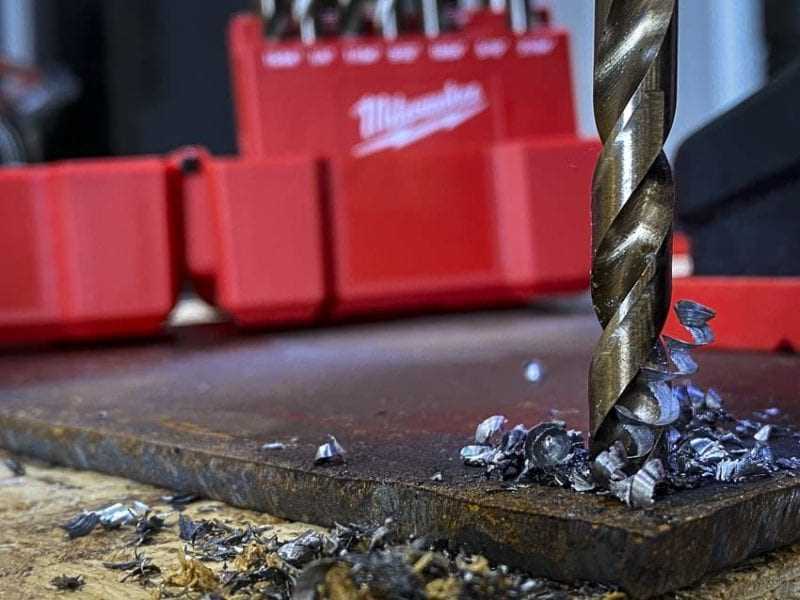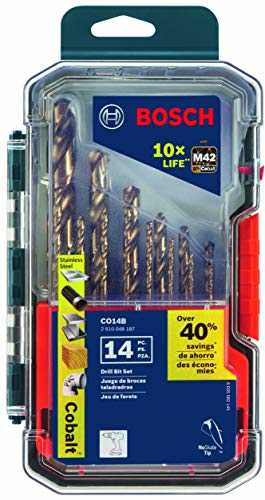Best drill bit to cut stainless steel

If you are working with stainless steel materials, you may know that not all drill bits are created equal when it comes to cutting through this tough and durable material. Stainless steel requires a specific type of drill bit that is designed to withstand the high heat and pressure that is generated during the drilling process.
One of the best drill bits to cut stainless steel is the cobalt drill bit. Cobalt drill bits are made from a high-speed steel alloy that contains a high percentage of cobalt. This makes them extremely hard and able to withstand the high heat and pressure that is generated when drilling through stainless steel. Cobalt drill bits also have a special coating that helps to reduce friction and increase the lifespan of the drill bit.
Another option for cutting stainless steel is the titanium drill bit. Titanium drill bits are made from high-speed steel that has been coated with titanium nitride. This coating makes the drill bits extremely hard and resistant to wear. Titanium drill bits have a longer lifespan than regular drill bits and are designed to maintain their sharpness for a longer period of time.
Factors to consider when choosing a drill bit for stainless steel

Drilling through stainless steel requires a specific type of drill bit that can handle the hardness and durability of the material. There are several factors to consider when choosing the best drill bit for stainless steel to ensure efficient and effective drilling.
One important factor to consider is the material composition of the drill bit itself. Look for a drill bit made from high-speed steel (HSS) or cobalt. These materials are known for their hardness and heat resistance, making them ideal for drilling into stainless steel. Additionally, consider the coating of the drill bit. Titanium coating, for example, can help reduce friction and heat, enhancing the durability and longevity of the drill bit.
Another factor to consider is the drill bit’s design and shape. For drilling through stainless steel, choose a drill bit with a split point or a 135-degree angle. This design helps to reduce the amount of force needed to penetrate the material and prevents the drill bit from walking or wandering during the drilling process. A shorter flute length can also provide more stability and control when drilling into stainless steel.
Lastly, consider the size and diameter of the drill bit. Opt for a drill bit that matches the size of the hole you need to make. Using a larger drill bit than necessary can cause unnecessary vibrations and can result in imprecise holes. It is also important to use a sharp drill bit to ensure clean and accurate drilling.
- Choose a drill bit made from high-speed steel or cobalt.
- Consider a drill bit with a titanium coating.
- Look for a drill bit with a split point or a 135-degree angle.
- Consider a shorter flute length for more stability and control.
- Select the appropriate size and diameter for the hole.
- Use a sharp drill bit for clean and accurate drilling.
Carbide Drill Bits for Cutting Stainless Steel
When it comes to cutting stainless steel, choosing the right drill bit is crucial for achieving clean and precise results. One of the best options for this is carbide drill bits. These bits are specifically designed to cut through stainless steel, offering excellent performance and durability.
Carbide drill bits are made from a combination of carbide and cobalt, which makes them extremely hard and resistant to heat. This allows them to maintain their sharpness and cutting ability even when drilling through tough materials like stainless steel. Additionally, the carbide tip of these drill bits is designed to create small chips instead of larger ones, which helps to prevent the bit from getting clogged and ensures a smooth cutting process.
Another advantage of carbide drill bits for cutting stainless steel is their ability to maintain their cutting edge for longer. This means that they can be used for a longer period of time before needing to be sharpened or replaced. Additionally, the carbide material is less prone to wear and tear, which further contributes to the longevity of these drill bits.
Overall, carbide drill bits are a reliable and efficient tool for cutting stainless steel. With their excellent cutting performance, durability, and ability to maintain their sharpness, these drill bits are a top choice for professionals and DIY enthusiasts alike.
Cobalt Drill Bits for Stainless Steel Cutting

When it comes to cutting stainless steel, using the right drill bit is essential for achieving accurate and efficient results. One of the best options to consider is cobalt drill bits. These drill bits are specifically designed for cutting through tough materials like stainless steel.
What makes cobalt drill bits ideal for cutting stainless steel is their composition. They are made from a combination of cobalt and high-speed steel, which gives them exceptional hardness and heat resistance. This enables them to withstand the high temperatures generated when drilling into stainless steel, preventing the drill bit from dulling or overheating.
Cobalt drill bits also have a unique flute design that helps in chip evacuation. The flutes are designed to effectively remove chips from the hole as you drill, preventing clogging and allowing for smoother drilling. This feature is particularly important when working with stainless steel, as the metal tends to create more chips that can easily jam standard drill bits.
Overall, when it comes to cutting stainless steel, cobalt drill bits are a reliable choice. Their hardness, heat resistance, and chip evacuation capabilities make them well-suited for drilling through this tough material. Whether you are a professional or a DIY enthusiast, having a set of cobalt drill bits in your toolbox will ensure that you can handle any stainless steel cutting task with ease and precision.
Titanium drill bits for cutting stainless steel
When it comes to cutting stainless steel, using the right drill bit is crucial to ensure clean and precise holes. One type of drill bit that is highly recommended for this job is titanium drill bits.
Titanium drill bits have a coating of titanium nitride, which makes them extremely durable and resistant to heat. This allows them to effectively cut through tough materials like stainless steel without getting damaged. The titanium coating also reduces friction, making the drilling process smoother and minimizing the risk of overheating.
These drill bits have a sharp and pointed tip, which helps to create an initial hole in the stainless steel. They also have flutes along the body, which help to remove debris and keep the hole clean. The high-quality construction of titanium drill bits ensures that they can effectively cut through stainless steel without dulling quickly or breaking.
It is important to choose the right size of titanium drill bit for the job, as using a smaller or larger bit can result in ineffective cuts or damage to the material. Using a drill press is also recommended for cutting stainless steel with titanium drill bits, as it provides a stable and controlled drilling process.
In conclusion, titanium drill bits are an excellent choice for cutting stainless steel. Their durable construction, heat resistance, and effective cutting capabilities make them ideal for this task. By using the right size and a drill press, you can achieve clean and precise holes in stainless steel with titanium drill bits.
5 Best drill bit to cut stainless steel
Features
| Part Number | SCTBA5 |
| Model | 2021-01FU-4-13281 |
Features
| Part Number | B0518DE |
| Color | Gold |
| Size | set |
Features
| Part Number | Drill Bit Set |
| Language | English |
Features
| Part Number | 19.165 |
| Color | Blacksmith (Metric) |
| Size | 16.5x150mm |
Question-answer:,
What are titanium drill bits?
Titanium drill bits are specifically designed drill bits that have a coating of titanium nitride (TiN) applied to the surface. This coating improves the durability and performance of the drill bits, making them suitable for various drilling applications.
Are titanium drill bits suitable for cutting stainless steel?
Yes, titanium drill bits are suitable for cutting stainless steel. The titanium coating on the drill bits helps to reduce friction and heat buildup during the drilling process, which makes them highly effective for drilling through stainless steel.
Do titanium drill bits wear out quickly?
Titanium drill bits generally have a longer lifespan compared to regular drill bits. The titanium coating provides extra hardness and resistance to wear, allowing the drill bits to last longer even when cutting through tougher materials like stainless steel.
Can titanium drill bits be used with other materials?
Yes, titanium drill bits can be used with other materials besides stainless steel. They are also suitable for drilling through wood, plastic, and softer metals. However, it is important to match the drill bit size and speed to the specific material to achieve the best results.
Are titanium drill bits more expensive than regular drill bits?
Generally, titanium drill bits are slightly more expensive than regular drill bits. However, considering their durability and performance, they are worth the investment, especially if you frequently work with stainless steel or other hard materials.
Can titanium drill bits be used for cutting stainless steel?
Yes, titanium drill bits can be used for cutting stainless steel. Titanium coating provides these bits with extra strength and durability, allowing them to drill through hard materials like stainless steel efficiently.
Conclusion
In conclusion, titanium drill bits are a highly effective tool for cutting stainless steel. Their unique coating provides increased durability and heat resistance, making them ideal for tackling tough materials. With their sharp and precise cutting edges, they ensure clean and precise holes, minimizing the risk of damage or distortion to the stainless steel. Whether for professional use or DIY projects, titanium drill bits are a reliable choice for stainless steel cutting. Investing in these high-quality bits will provide long-lasting performance and make the cutting process faster and more efficient.


![[2022 Upgraded]3Pcs Nail Drill Bits Set, 5 in 1 Drill Bits for Nails 3/32 Inches, Tapered Barrel and Cone Shape Carbide Nail Drill Bits for Acrylic or Gel Remover](https://m.media-amazon.com/images/I/41WLrJOa7QL._SS520_.jpg)







